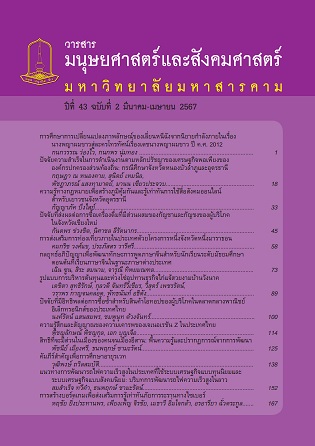ปัจจัยที่มีอิทธิพลต่อการซื้อซ้ำสำหรับสินค้าโอทอปของผู้บริโภคในตลาดกลางพาณิชย์อิเล็กทรอนิกส์ของประเทศไทย
Main Article Content
บทคัดย่อ
งานวิจัยนี้มีวัตถุประสงค์เพื่อ ศึกษาปัจจัยที่มีอิทธิผลต่อการซื้อซ้ำของผู้ซื้อในตลาดกลางพาณิชย์อิเล็กทรอนิกส์ของประเทศไทย กลุ่มตัวอย่าง คือ ผู้ที่เคยซื้อสินค้า OTOP จำนวน 400 ราย ผ่านเว็บไซต์ตลาดซื้อขายสินค้าของภาครัฐ เครื่องมือที่ใช้ในการวิจัย คือ แบบสอบถาม สถิติที่ใช้ในการวิเคราะห์ข้อมูล ได้แก่ ความถี่ ค่าร้อยละ ค่าเฉลี่ย ค่าเบี่ยงเบนมาตรฐาน สถิติการวิเคราะห์ถดถอยพหุคูณ
ผลการวิจัยพบว่า 1) ปัจจัยส่วนประสมทางการตลาด (Marketing Mix) ผลิตภัณฑ์ (Product) ช่องทางการจัดจำหน่าย (Place) การส่งเสริมการตลาด (Promotion) มีอิทธิพลต่อความพึงพอใจของผู้ซื้อ 2) ปัจจัยคุณภาพการบริการ (Service Quality) ด้านประสิทธิภาพ (Efficiency) ด้านความเชื่อมั่นในบริการ (Reliability) ด้านความลับข้อมูลส่วนบุคคล (Privacy) มีอิทธิพลต่อความพึงพอใจของผู้ซื้อ 3) ความพึงพอใจ (Satisfaction) มีอิทธิพลต่อความตั้งใจซื้อซ้ำ (Repurchase Intention) ของผู้ซื้อ อย่างมีนัยสำคัญทางสถิติที่ระดับ 0.05
Article Details
References
กระทรวงดิจิทัลเพื่อเศรษฐกิจและสังคม. (2565). รายงานผลการสํารวจพฤติกรรมผู้ใช้อินเทอร์เน็ตในประเทศไทย ปี 2565. กระทรวงดิจิทัลเพื่อเศรษฐกิจและสังคม.
กัลยา วานิชย์บัญชา และฐิตา วานิชย์บัญชา. (2564). การใช้ SPSS for Windows ในการวิเคราะห์ข้อมูล. โรงพิมพ์สามลดา.
ศิริวรรณ เสรีรัตน์. (2546). การบริหารการตลาดยุคใหม่. บริษัท ธรรมสาร จำกัด.
สุณิสา ตรงจิตร. (2559). ปัจจัยที่มีอิทธิพลต่อการตัดสินใจซื้อสินค้าออนไลน์ผ่านช่องทางตลาดกลางพาณิชย์อิเล็กทรอนิกส์ (E-Marketplace) [การค้นคว้าอิสระปริญญามหาบัณฑิต]. มหาวิทยาลัยธรรมศาสตร์, กรุงเทพมหานคร.
Chau, V. S., & Kao, Y. Y. (2009). Bridge over troubled water or long and winding road? Gap-5 in airline service quality performance measures. Managing Service Quality, 19(1), 106–134.
Chen, Y., Yan, X., Fan, W & Gordon, M. (2015). The joint moderating role of trust propensity and gender on consumers’ online shopping behavior. Computers in Human Behavior, 43(2015), 272–283.
Cheng, H-H., & Huang, S-W. (2012). Exploring antecedents and consequence of online group-buying intention: An extended perspective on theory of planned behavior. International Journal of Information Management, 33(1), 185-198.
Cuong, D. T. (2020). The effect of physical environment and perceived value on customer satisfaction and behavioral intention at the cinema in Vietnam. Test Engineering and Management, 82(1–2), 1665–1674.
El-Adly, M. I. (2019). Modelling the relationship between hotel perceived value, customer satisfaction, and customer loyalty. Journal of Retailing and Consumer Services, 50(1), 322–332.
Goutama, D., & Gopalakrishnab, B.V. (2018). The impact of E-service quality and E-loyalty on online shopping: Moderating effect of E-satisfaction and E-trust. Management Science Letters, 8(2018), 1149-1158.
Ilyas, R., Tamsah, M., & Putra (2020) Reflective model of brand awareness on repurchase intention and customer satisfaction. Journal of Asian Finance, Economics and Business, 7(9-2020), 427–438.
Karim, R., Latip, N, A., Marzuki, A., Haider, S., Nelofar, N. & Muhammad, F. (2021). The impact of 4Ps marketing mix in tourism development in the mountain areas: A case study. International Journal of Economics and Business Administration, 6(2), 231-245.
Kotler, P., & Armstrong, G. (2010). Principles of marketing. Pearson education.
Kotler, P., & Armstrong, G,. (1994). Principles of Marketing (6th ed). Prentice-Hall international.
Krejcie, R. V., & Morgan, D. W. (1970). Determining sample size for research activities. Educational and Psychological Measurement, 30(3), 607–610.
Li, F., Lu,H., Hou ,M., Cui, K., & Darbandi, M. (2021).Customer satisfaction with bank services: The role of cloud services, security, e-learning and service quality. Technology in Society, 64(2021) ,1-11.
Long, C. & Khalafinezhad, R. (2012). Customer satisfaction and loyalty: a literature review in the perspective of customer relationship management. Journal of Applied Business and Finance, 1(1), 6-13.
McCarthy, E. J. (1960). Basic marketing. Richard D. Lewin.
Moon, Y. & Armstrong, D.J. (2020). Service quality factors affecting customer attitudes in online to offline commerce. Information Systems and e-Business Management, 18(2020), 1-34.
Mustawadjuhaefa, Basrimodding, Jobhaarbima, M., & Ilhamlabbase (2017). Marketing mix and service quality effect on customer satisfaction and loyalty of Toyota cars. Journal of Research in Business and Management, 5(2),13–23.
Oliver, R.L. (1980). A cognitive model of the antecedents and consequences of satisfaction decisions. Journal of Marketing Research, 17(4), 460-469.
Parasuraman, A., Zeithaml, V.A., Malhotra, A., 2005. E-s-qual a multiple-item scale for assessing electronic service quality. J. Serv. Res., 7(3), 213–233.
Pham, N., Coomer, T., Lane, P., Limbu, Y. B., Williamson, S., & Pham, L. (2020). Technology readiness and purchase intention: Role of perceived value and online satisfaction in the context of luxury hotels. International Journal of Management and Decision Making, 19(1), 91-117.
Rita, P., Oliveira, T., & Farisa, A. (2019). The impact of e-service quality and customer satisfaction on customer behavior in online shopping. Heliyon, 5(2019), 1-14.
Saleem,M,A., Zahra.S., & Yaseen.A. (2017). Impact of service quality and trust on repurchase intentions – the case of Pakistan airline industry. Asia Pacific Journal of Marketing and Logistics, 29(5), 1136-1158.

